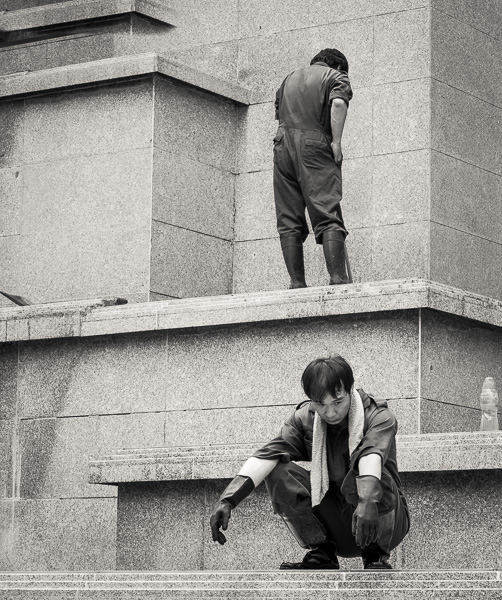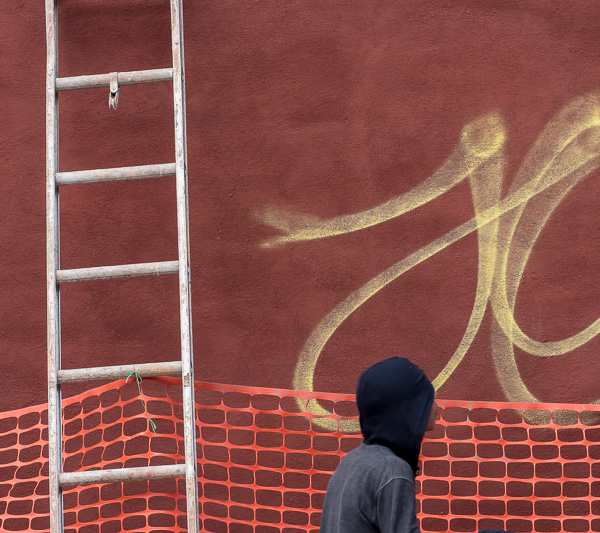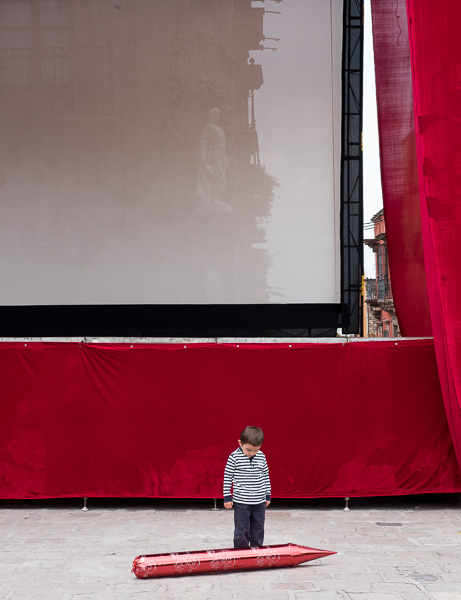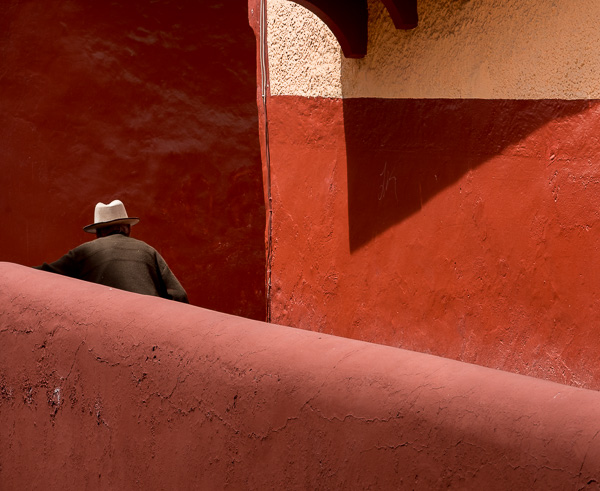by Alain Briot
Alain Briot is one of the most successful landscape photographers working in the American Southwest today. His work is widely exhibited and collected. His new monthly column for this web site, of which this is part, is calledBriot’s View. An extensive interview with Alain is included in Issue #1 ofThe Luminous Landscape Video Journal.
Salesmanship
To sell or not to sell (your photographs), that is the question. Although the implications may not be as far reaching as those faced by Hamlet they still have the potential for keeping us awake at night. In this article I would like to address the main issues associated with deciding to sell your work. To do this I will proceed through a series of simple questions. Think of each question as a fork in the road and of each answer as taking a specific direction at each fork. As I move along this road I will provide my own answers to these questions to point out the path that I am following.
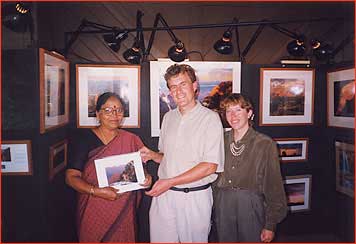
When selling directly you become one of the reasons people will buy your work and the relationships you develop with customers can be a reward in itself. This customer wanted a photograph of her with me and my wife, Natalie, to show her friends in India.
She mailed me this photograph to thank me.
We may start with the obvious because after all it is a decision in itself:do you want to sell your work?If you decide that yes, you want to sell your work (like I did) ask yourself why you want to sell it? Do you need the income (I did) or do you want others to be able to enjoy your work while deriving the majority of your income from another occupation?
Having decided that you want to sell your work (and why) you are ready for the next fork.How do you want to sell your work?There are basically three venues offered to you: you can sell wholesale, or through consignment, or via shows where you are personally present. I chose the third option so far, and I sell my work myself at shows. This involves direct contact with the public, long hours of presence at the show, and hard work setting up and taking down displays and photographs. I personally enjoy this approach but I realize this is not for everyone. First it is difficult to have a second “real” job (I don’t). Second, you have to enjoy working with the public and answering many questions all day long (I do). Third, you have to charge sales tax and pay it back to your state. Fourth, you need to carry a relatively large inventory consisting of framed and unframed photographs in matted sizes of 8×10, 11×14, 16×20 and 20×30 or larger. The framed pieces help sell the unframed pieces so you should expect to sell more unframed than framed pieces. Your choice of frame and matting is very important and should fit the type of home decor your photographs will fit in.
 Burning Bush #3
Burning Bush #3
Visual metaphors can be very powerful. Relatively few people in the world have been to Antelope Canyon, where this image was created. However, the title points to a story known to many.
Selling on the internet can be considered part of selling your work yourself. A look at my web site will show my approach to web sales. However, my experience is that selling artwork on the internet is difficult. At this time internet sales represent only a small percentage of my total sales.
Selling wholesale is another viable option. In this approach you sell your work to retail stores who take care of displaying it and selling it to customers. Traditionally the wholesale price is 50% of the actual retail price meaning you make half the money that the store will sell the item for. Your margin of profit is smaller than if you were in a retail situation but if you manage to get a wholesale account in a large store they may be able to sell far more than you would on your own. Also, your job ends when the store purchases your work and you can devote the rest of your time to other activities. Because wholesale sales are not subject to sales tax you don’t have to worry about that either. Small, moderately priced items work best for wholesale. Traditionally notecards, postcards, posters, and 8×10 matted photographs have been the items of choice in the wholesale business. You may have to provide stores with displays to present your work.
If you want to sell large expensive pieces then wholesale is probably not the way to go. If such is your desire you should consider selling your work yourself or looking into consignment. Consignment is the third option and this is how most art galleries operate. With consignment a store agrees to display and sell your work but will not pay you until the items sell. There is good news and bad news regarding this approach. The bad news is that if your work does not sell you do not get any money. The good news is that since the gallery does not have to buy your work they will usually agree to carry and display larger and more expensive pieces. Finally, the gallery takes care of handling sales tax.
Working with a gallery also provides opportunities for shows, openings, announcements and newspaper or magazine articles. Over time this will allow you to develop name recognition -and fame- in the area covered by the gallery. However, be aware that fame and fortune do not necessarily go hand in hand. It is easy to be famous and poor at the same time.
Pricing
These three options bring us to the question of pricing. How much do you want to charge for your work? To put it in a nutshell there are two possible approaches to pricing: you can decide that you want to sell a lot of inexpensive pieces or you can decide that you prefer to sell only a few very expensive pieces . I chose the first option (selling a lot of pieces).
Let us simplify the situation and suppose that your goal is to make $20,000 this year selling your photographs. To reach this goal you have several options as far as pricing your work is concerned:
You can sell a single, monumentally large and hopefully incredibly stunning photograph for $20,000 or you can sell…
2 for $10,000 each
4 for $5000 each
8 for $2500 each
16 for $1250 each
32 for $750 each
64 for $313 each
128 for $157 each
256 for $78 each
512 for $40 each
1024 for $20 each or
2048 for $10 each
In this simplified example how much you want to charge and how many photographs you want to sell (or can create in one year) decides on where you fall on the scale. You may think that this example is oversimplified. It is not. Just read it again and you will see that the whole issue of pricing your work is contained in it. If you desire to reach a higher income just start with a single photograph at this higher income level and work your way down.
There are basically three questions embedded in the above example :
First,how much are you comfortable selling your work for?
Second,how many pieces can you realistically expect to sell in one year?
Third,what audience are you addressing?
In my case I first have the potential of selling thousands of pieces a year. Second, I feel comfortable charging up to $1200 for a photograph. Third, I sell in a highly touristic area and want to reach the largest audience I can. For this reason I decided to go for many moderately priced photographs rather than a few high priced photographs. Because my audience consists of a variety of different customers I also decided to complexify the pricing example provided above and to offer my work in different sizes and presentations in order to be able to offer a variety of prices and sizes. Currently my prices range from $15 for an unframed 8×10 to $625 for a framed 18×40 panoramic. My photographs are matted and are available framed and unframed.
This brings us to the next question:how do you price your work?I know of only one method to price your work and that is to use the following formula:
First, add the cost of all the materials used to create your photograph: the cost of the print (paper + inks or chemicals), the cost of the mat board and the mounting tape if the photograph is matted, the cost of the plastic bag if the photograph is presented in a crystal clear bag, the cost of the frame plus glass and back if it is framed, the cost of the framing supplies (wire, screws, framing staples) etc. Count everything you used since it is part of the final product. Remember that you paid for all these supplies and that you should charge the customer for them.
Second, estimate how many hours it took you to create this photograph and multiply this figure by how much you want to make an hour. Add this to the previous figure.
Third, multiply this figure by 2 at the very minimum (I suggest you multiply your costs by a factor higher than 2 (I do) but how much you want to multiply your costs by is totally up to you). This is your wholesale price. To get the retail price multiply the wholesale price by two.
Fourth, once you have reached the above figure compare it to the prices photographers in your area are charging for work of similar size and quality. If your prices are much higher you may want to look into your costs and reduce them. If your prices are much lower you may want to raise them since people will most likely expect to pay what your competitors are asking. You can under price your competitors (always a good idea) but there is no need to offer the same item at half the price they are asking.
The one mistake to avoid making is to confuse income and profit. Income is what you receive from stores or customers. Profit is what is left in your pocket after you have paid your expenses, your supplies and your taxes. If you spend all that you make you will soon end up in debt.
In my outline of the different venues available to sell your work I have not mentioned books or magazines. Certainly these are viable venues for your work but if you are just starting publishing is very difficult to break into. Magazines pay only a few hundred dollars for a cover image and far less than that for an article illustration. Many do not pay anything at all and you have to content yourself with getting credit for having taken the photograph. Unless you can develop a regular publishing relationship with a magazine, or find a stock agency to represent yourself and carry your work, it is difficult to make a living with book or magazine publishing.
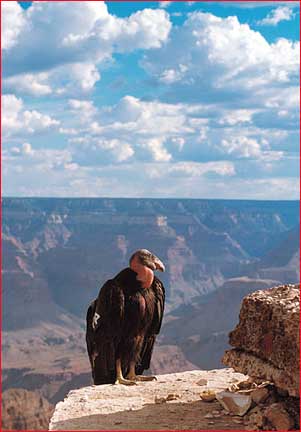
Condor, Grand Canyon National Park, South Rim
In the search for bestsellers rare, uncommon or newsworthy subjects can be valuable additions to your photographic collection.
Condors were recently re-introduced to Grand Canyon National Park and this event has generated a lot of media coverage as well as excitement.
Visitors want to bring back photographs of this elusive raptor and if you have the goods you may be in business.
Thinking about all these issues takes us very far from simply creating photographs and enjoying the results in the privacy of our homes. Certainly, if you decide to sell your work, you will have to wear two hats: that of a photographer and that of a businessman. You will also have to schedule your activities so that you have time to sell and market your work and time to photograph and create new images.
So why should we bother with all this? In my case the underlying reason is two folds: first, I want to make a living doing what I like. Second, I want to be in charge of my own destiny. Marketing and selling my work is the key to reaching these two goals and I find it just as exciting as taking photographs.
I understand that this is not for everyone but for those who will choose to go for it I hope the above will provide a solid starting point. If you have any questions about this subject, or if you would like me to cover any additional aspects of selling your work, donºt hesitate to contact me.
Where do you go from here?
At this point you may have many questions about where to get equipment, how to price your work, how many pieces you need to take to a show and more. All these questions, and many more, are answered in my book: Marketing Fine Art Photography. This book is available both as a printed book and as an eBook.
If you want to go further, I also offer an in-depth tutorial titled the Marketing Mastery Workshop on DVD. Finally, if you need personalized help, I offer one on one consulting over the phone and in my studio for marketing and other aspects of photography.
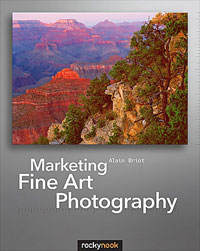
Alain Briot
Chinle, Arizona
September, 2001
[email protected]
http://www.beautiful-landscape.com
Another approach to selling ones photography is to self-publish aMonograph. There is a tremendous amount of work involved in doing so, but it can be a gratifying and financially rewarding method for publishing ones work.
Michael
This is one of a regular series of exclusive articles byAlain BriotcalledBriot’s View
Read this story and all the best stories on The Luminous Landscape
The author has made this story available to Luminous Landscape members only. Upgrade to get instant access to this story and other benefits available only to members.
Why choose us?
Luminous-Landscape is a membership site. Our website contains over 5300 articles on almost every topic, camera, lens and printer you can imagine. Our membership model is simple, just $2 a month ($24.00 USD a year). This $24 gains you access to a wealth of information including all our past and future video tutorials on such topics as Lightroom, Capture One, Printing, file management and dozens of interviews and travel videos.
- New Articles every few days
- All original content found nowhere else on the web
- No Pop Up Google Sense ads – Our advertisers are photo related
- Download/stream video to any device
- NEW videos monthly
- Top well-known photographer contributors
- Posts from industry leaders
- Speciality Photography Workshops
- Mobile device scalable
- Exclusive video interviews
- Special vendor offers for members
- Hands On Product reviews
- FREE – User Forum. One of the most read user forums on the internet
- Access to our community Buy and Sell pages; for members only.





